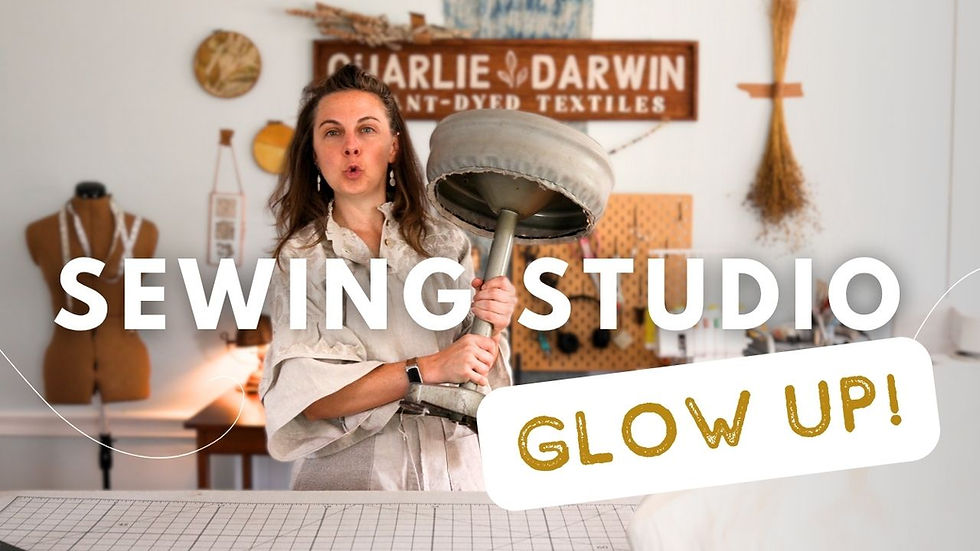Fast Fashion's Environmental Impact // Environmental Activism and Art!
- Leah Widdicombe

- Sep 7, 2022
- 4 min read
Updated: May 1, 2023
The Environmental Impact of Fast Fashion and Synthetic Fiber Clothing
Did you know that microplastic fibers from polyester and nylon clothing are not only overloading landfills globally, but they are also the most frequent microplastic type polluting oceans and ingested by wildlife, particularly in ocean ecosystems? Here are some quick details about fast fashion's environmental impact on microplastic pollution:


I wanted to start more conversations about how fast fashion is impacting the environment and polluting our oceans. So, using my skillset at as a textile artist...
I made an environmental activism tapestry!
With my thrifted hot pink fuzzy socks and yellow rubber raincoat in hand, I made visible the invisible journey of microplastic fibers through our clothing and into our waterways, exploring the environmental effects of what we wear and how we throw it away.
Making a tapestry by upcycling used clothes
The synthetic portion of the tapestry is composed of thrown-away fast fashion garments and (embarrassingly) some of my personal clothing!
Here are the synthetic-fiber garments that I upcycled:

Deconstructing and recombining the used clothes:
The top and middle portions of the tapestry were created by deconstructing the garments and recombining them through unusual methods, which I explain later in this post. These plastic-y fabrics are in stark contrast to those on the bottom portion of the tapestry, which is composed of 100% plant-based fabrics (linen and cotton) and plant-based dyes (indigo, logwood, onion, acorns, leaves). I use these same plant-based fabrics and dyes for my eco-friendly clothing business.

If you want to get the full experience...
Check out this video where I discuss the environmental impact of fast fashion and microplastic pollution, and I show the full process of how I created the "Feeding on Our Fibers" tapestry...
See more detail shots of Feeding on Our Fibers:
Gallery slideshow (click the arrows to navigate):
How I Constructed this Environmental Activism Tapestry:
The top portion - Synthetic Fiber Clothing, Quilted
Cut from various thrifted/found, used garments that were originally made from plastic fibers such as polyester, nylon, or acrylic. In person, you'll be able to quickly identify the texture of a pair of hot pink fuzzy socks from Dollar Tree, blue Victoria's Secret underwear, an orange GAP sweater, yellow Old Navy raincoat, navy Walmart t-shirt, coral "Baby Phat" purse, pink Kohl's scarf, rainbow Walmart swimsuit, and a pair of Kohl's burgundy pants, among a few others. The pieces were selected for their colors and fiber content, so the store brands were not intentionally sought out for the project, but were identified later in the process of making. Interestingly though, all of these stores are guilty of also contributing to fast-fashion in some way.
The middle portion - Tangled Fibers
Cut from the same old garments above, with the addition of several more polyester yarns, threads, and fabric remnants. In an arduous process, these were sliced into thin ribbons using a rotary cutter, then machine quilted in a sandwich of interfacing that I later washed away to expose the crazy entanglement of threads and fibers. Unlike tiers 1 and 3, this middle portion exposes the space between the fibers, so you can see gaps and holes that show the wall/living space behind it (similar to a spider web).
The final, bottom portion - Naturally dyed and hand-appliqued seascape
Cut from all natural fibers, primarily linen, cotton, and a cotton-linen blend, that I hand-dyed using pigments from plants. The dye materials included acorns (grey), indigo (blue), black beans (bluish-purple), onion skins (yellows and burnt oranges), logwood (purple), black tea (grey). The wave pattern in the water was hand stitched using cotton embroidery thread, and the fish were pieced together and sewn on using a hybrid of machine and hand sewing. Waves of plastic fibers from tier 2 were mindfully pulled into tier 3, and hand stitched into place.

Hanging - Plastic Clothes Hanger
The tapestry has a sleeve at the top that encases a wooden rod with a small eye-hook on each end that can hang onto nails or picture hangers. The pink plastic clothes hanger is not attached, (because insync with the metaphor of this tapestry, it is made so cheaply that it cannot bear any weight!), so you could secure it behind the quilt top as it was placed in the photos, or choose to disclude it from the hanging (when placed the way it was for the photos, it adds an additional 8" to the total length of the piece).

Challenges for expressing activism through art
For me, the hardest part of expressing activism through art is finding a way to make an attractive visual representation of something that's ugly, invisible, and not widely talked about, but I think it's a challenge well worth the hard work and deep thinking!
"Feeding on our Fibers" is on display at the exhibition Re-Imagining Conservation: From Many Viewpoints. The exhibition will run from July 1 through November 13, 2023 at the National Museum of Wildlife Art in Jackson Hole, Wyoming.
To purchase 'Feeding on our Fibers' after it returns from the show:
This piece is currently for sale for $1,300 + shipping.























































































![Reflecting on my handmade clothing business in 2024! [What worked and what flopped??]](https://static.wixstatic.com/media/a2e172_298b8e79f0d04eeaa72215c0ab3d671a~mv2.jpg/v1/fill/w_980,h_1470,al_c,q_85,usm_0.66_1.00_0.01,enc_avif,quality_auto/a2e172_298b8e79f0d04eeaa72215c0ab3d671a~mv2.jpg)

Comments